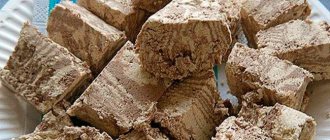Sometimes there is a sharp change in the color of stool. This can occur against the background of various pathological and physiological disorders in the body. Black stool in a child does not always indicate serious illness.
Often this condition occurs as a result of eating certain foods or taking certain medications. But you should not ignore the change in color of stool in children.
Experts identify many reasons, including dangerous ones, that can trigger the development of serious diseases.
Why can a child's stool change color?
According to statistics, dark stool in children implies the development of stomach pathologies or hemorrhage in the esophagus. This is explained by the fact that when blood is released in the upper part of the digestive system, its chemical decomposition occurs during the digestion of food.
It takes a relatively long period of time for the blood to reach the rectum, causing it to turn black. When blood is released in the lower part, the color will be bright red.
Most often, internal bleeding is not the root cause of changes in feces in childhood.
The appearance of this condition can be contributed to by various gastrointestinal diseases, individual characteristics of metabolic processes, or the food eaten.
For any changes in stool in children, you should consult a pediatrician.
Causes
There are many provoking factors that can cause a child’s stool to change color. The causes may vary in newborns and older children.
In newly born babies, the first bowel movement is called meconium. Discharge of black stool is observed on the second or third day after birth. The consistency of stool is viscous, sticky, and has no specific odor.
It is due to these components that the darkening of feces occurs.
Experts see no reason for parents to worry here.
As a rule, normalization of bowel movements occurs already on the 6th day. The color becomes yellowish-brown and the consistency becomes mushy.
The baby's digestive system has not yet formed, so the stool may remain dark in color and undigested food residues for a longer time. This occurs in most cases in premature babies.
Experts identify another reason that may contribute to dark stool coloration - individual lactose intolerance.
As a result of its inadequate digestion, irritation of the intestinal mucosa occurs, increased peristalsis and rapid passage of excrement through the intestinal canal, which contributes to their coloring black.
If lactase deficiency is noted, then, in addition to loose stools with various impurities and an unpleasant odor, such a condition will be accompanied by pain in the abdominal area, increased gas production and excessive regurgitation.
From about 10 months to 1 year, the color of stool can often change as a result of the introduction of complementary foods. This is especially true if the baby has been breastfed throughout the entire period.
This is explained by the fact that the digestive system, which has not yet become stronger, is capable of digesting only a small part of the food entering the child’s body.
The rest of it comes out undigested along with feces.
In a one-year-old child, the stool may change color even against the background of certain foods, for example, after beet puree, bananas, apples, grapes, cherries, and animal liver.
In children, both newborns and 2 years of age or older, various pathological processes can contribute to the appearance of black stool.
Depending on age, the provoking factors of bleeding may be different.
Before two years of age, the following conditions are often the causes:
At three years old, children often suffer from polyps, which also lead to bleeding. These are growths that form in the intestinal lumen.
The pathology is manifested by the presence of blood impurities in the stool and pain during bowel movements.
At the age of 8, black feces often appear with gastritis and ulcerative colitis. With an eroded lesion, the mucous membrane bleeds when particles of undigested food fall on it. Feces mix with blood, causing them to take on a dark color.
Adolescents are also characterized by the development of varicose veins of the stomach and esophagus, which can be triggered by increased pressure in the portal vein.
The initial stages of the disease may not manifest themselves in any way. As it progresses, there is a loss of strength of the vessel walls and bleeding.
Stool may become dark while taking certain medications. For example, black feces appear after activated charcoal, which is prescribed after diarrhea.
For iron deficiency anemia, iron medications and vitamin complexes are often prescribed.
Due to the fact that the drugs contain an increased content of this substance, the stool turns black. In this condition, the medication is not discontinued, since this is only a side effect.
After completion of treatment, spontaneous normalization of stool is noted.
The stool may also change after taking anti-inflammatory drugs (Aspirin, Nurofen or Nimesulide).
This is due to the fact that they contain bismuth. But when taking these medications for a long time, the development of bleeding cannot be ruled out, since there is a negative effect on the gastric mucosa.
Two types of milk
The terms "foremilk" and "hind milk" describe the difference between the composition of human milk during a single feeding. The milk at the beginning of feeding is called foremilk. Foremilk is plentiful and has a relatively low percentage of calories and fat. As suckling progresses, the amount of fat in the milk increases. The high-calorie milk that the baby sucks at the end of feeding is called hind milk. It is important for your baby to get enough of both foremilk and hindmilk for growth and development.
Based on these data, the question “Does the baby have enough milk?” can be answered with the question “Front or rear?” In the first weeks, counting wet diapers can only answer the first part of the question. Wet diapers indicate that the baby is sucking some foremilk. The baby simply will not be able to have bowel movements several times a day if he does not first suck out enough foremilk to maintain the body's water balance.
However, the opposite is possible. Feeding patterns, ineffective sucking, or other feeding problems can cause the mother's milk supply to decrease or prevent the baby from getting enough hindmilk. In this situation, it is quite possible that the baby is not dehydrated because he is sucking enough foremilk, but at the same time the baby is not getting enough calories because he is not sucking enough hindmilk. Thus, frequent urination is a reliable sign of drinking enough fluid from the sucking of foremilk. Repeated bowel movements are a sign of getting enough calories from hind milk. To fully evaluate breastfeeding in the neonatal period, it is important to consider both conditions.
Lack of bowel movements during the newborn period may be due to insufficient caloric intake and may also be a symptom of poor weight gain. Early detection of this sign can be critical to both the overall well-being of the baby and continued feeding. In advanced cases, a lack of calories can lead to weakened sucking, reduced milk production and severe dehydration. Despite the fact that simple causes of calorie deficiency can be eliminated at any stage of feeding, it is easiest to establish lactation, take care of sufficient milk production and normal weight gain immediately after childbirth. The longer you delay solving a problem, the more time and effort it will take to resolve it.
Basic information
Black stool can be a serious symptom
People often pay attention to the nature of their discharge. A change in the color of urine or stool often causes alarm and is a reason to consult a doctor. Normal stools are brown in color because the stool contains bile residues.
If food is digested faster than expected, the stool may acquire a greenish tint due to insufficient decomposition of bile. White stool may indicate blockage of the bile ducts.
In medical practice, black tarry stools are primarily associated with hemorrhage in the esophagus or stomach. The fact is that the blood released in the upper parts of the digestive tract undergoes chemical decomposition during the digestion of food.
It takes a long time before such blood reaches the rectum. As a result, the blood turns black. In contrast, blood released in the lower intestines will have a characteristic bright red color.
Fortunately, bleeding is not the most common cause of dark stool. This color can be the result of food eaten, metabolic characteristics, or diseases. However, any change in a child's stool should be a reason for diagnosis, since the health of the digestive system is of primary importance for a growing organism.
What should a baby's stool look like at different ages?
The ideal stool for a newborn baby is a uniform yellow consistency without additional inclusions, however, such stool is observed exclusively in bottle-fed babies, since in this case the baby receives the same mixture, which, accordingly, is digested in the same way. It’s a completely different matter for babies who are breastfed. In this case, the stool may have additional lumps and mucous layers, it may be of different colors, since the condition of the stool is affected by the foods that the mother ate.
Examination of the baby's stool will help to promptly identify possible nutritional deficiencies, so every mother should know what her baby's stool should look like at different ages:
- In the first three days, the baby poops a black-green mass, such stool is called meconium. It consists mainly of amniotic fluid, which the baby fed on before birth;
- starting from the 3rd day and until the end of the first week, the stool may be gray or gray-green, while the norm is a liquid consistency of the mass. Such feces indicate that the baby is receiving enough milk and it is being successfully digested by the body;
- from the second week of life to 3 months, the child should poop up to 10 times a day (sometimes there will be as many bowel movements as there were feedings), the stool will be yellow or mustard in color, and has a sour smell. This indicates adequate nutrition and normal bowel function;
- From about 4-5 months, the baby’s stool should be brown or brown with inclusions; such a mass has an unpleasant, pungent odor. This is the norm for a baby starting to receive complementary foods; the main characteristic is that the stool should not be hard, with a consistency similar to putty;
- After six months, a newborn’s stool may have an unusual color, the reason being the vegetables and fruits used as complementary foods. For example, beets give the mass a bright red color, carrots turn the stool orange, and zucchini can cause greenish streaks to appear in the diaper.
Useful: How to help a child who has eaten the wrong pill?
Constantly monitoring the condition of bowel movements will prevent all kinds of stomach upsets and protect the child from unnecessary discomfort.
There is no single definition of how many times a baby should poop per day, but for newborns in the first month, the norm is considered to be from 4 to 12 bowel movements per day. Over time, they will become more rare, but up to a year the baby can walk “big” several times a day.
Common Causes of Stool Discoloration
Light yellow stool is often observed in children and is considered normal.
The food eaten travels a long way in the human digestive tract. After swallowing, food substrates almost immediately end up in the stomach.
Digestion in the stomach lasts from two to three hours, after which the food enters the intestines. Intestinal digestion is distinguished by its duration - food can be processed for 6 hours and subsequently deposited in the colon during the day.
Thus, consumed food turns into feces 18-36 hours after consumption. During this time, a variety of factors can affect the color of the stool.
Reasons for color change:
- Changing your diet. Eating beets, tomatoes, beans, green leafy vegetables, and foods with food coloring can affect the color of your stool.
- Medicines. The color of the discharge can be affected by intestinal antibiotics, anticoagulants and other drugs.
- Diarrhea, characterized by watery discharge.
- Constipation. Stagnation of food masses in the colon can lead to a change in the color of the discharge due to the decomposition of individual components.
- Hemorrhoids and anal fissures.
- Rectal cancer.
- Intestinal ischemia.
- Colon polyps.
- Gastritis and gastroduodenitis.
- Inflammatory bowel diseases: Crohn's disease, ulcerative colitis.
- Cirrhosis of the liver.
- Celiac disease. With this disease, the intestines do not absorb gluten. The stool may be yellow and greasy.
- Intestinal injury due to ingestion of a foreign body.
The main reasons for the appearance of black stools:
- Taking aspirin, warfarin, clopidogrel, non-steroidal anti-inflammatory drugs and bismuth preparations. Painkillers can also cause bleeding if you have a peptic ulcer.
- Consuming licorice, blueberries and other coloring foods.
- Taking iron supplements.
- Lead ingestion.
- Bleeding varicose veins of the esophagus.
- Inflammatory diseases of the esophagus and stomach.
The listed reasons can cause not only a change in the color of stool, but also provoke the appearance of certain symptoms.
Symptoms of various conditions
Food also affects the color of stool
Black stool may not be the only sign of a digestive tract pathology. The following symptoms may also occur:
- Abdominal pain and cramps.
- Bloating due to increased gas production.
- Increased intestinal motility.
- Profuse diarrhea with bloody inclusions.
- Nausea and vomiting.
- Change in stool odor.
- Poor appetite.
- Pain and burning in the anal area.
- Unexpected weight loss.
Some of the listed symptoms indicate dangerous processes in the body. Immediate consultation with a doctor is required if the following symptoms are detected:
- Prolonged unexplained weight loss, fatigue, loss of appetite, sharp pain in the lower abdomen. These signs may indicate an oncological process in the large intestine. However, colorectal cancer is rarely detected in children.
- Prolonged vomiting with bloody inclusions. Bleeding may also be indicated by vomit the color of coffee grounds. Such signs indicate hemorrhage in the upper digestive tract.
- Stopping internal bleeding is possible only in a hospital setting.
What does unusual stool mean in a baby?
An unusual color or structure of feces in a newborn baby may indicate the reasons for the baby’s discomfort:
- green stool with a sour milk smell will not necessarily be a harbinger of the disease, if the child is gaining weight well and does not experience discomfort, this state of stool may be a common reaction to foods eaten by the mother;
- If the stool is watery and has a foamy structure, and irritation is often noticed around the anus, the cause may be an excess of sweet foremilk in the mother. The way out of the situation would be to first express the initial fluid from the breast;
- Bright yellow or green stool streaked with mucus can have three explanations:
- the child received a viral infection as a result of contracting ARVI or other infectious diseases;
- a common reaction to teething;
- enzyme deficiency in an unformed body;
- if the baby poops a dark brown dense mass, this may be a consequence of taking iron supplements, but if no additional medications were prescribed, it is worth reviewing the diet and slightly reducing foods containing this mineral;
- bright green foamy stool should alert you if your baby is restless and is not gaining weight well. Most often, this situation occurs due to lactose deficiency;
- Hard stool in a newborn baby is an anomaly, and it doesn’t matter what color it is. Constipation occurs due to the introduction of inappropriate foods into the diet; to eliminate the discomfort, you should find out what exactly such a reaction occurs to, which can be done by eliminating the ingredients;
- if the baby poops with diarrhea for a long time, this may be a consequence of dysbiosis, the best option would be to consult a doctor to prescribe suitable medications;
- feces with bloody elements are a very alarming symptom. The cause of this imbalance may be an allergy to milk, an infection, or intestinal bleeding. If you notice this type of stool, you should contact your doctor immediately.
Useful: How to recognize the first signs of rubella

Melena
Stool can be different shades for each person
As already mentioned, the appearance of black stools may indicate bleeding in the upper digestive tract.
The red color of blood is due to iron-containing hemoglobin. Any changes in blood color are also caused by chemical changes in hemoglobin molecules.
In the stomach, digestive juices act on the blood, which can cause black stools or vomit the color of coffee grounds. Doctors call this type of stool melena.
It is also important to be able to distinguish signs of bleeding in different parts of the digestive tract. Blood released below the stomach may be bright red, burgundy or crimson in color. This condition is called hematochezia.
The appearance of stool of a different color is explained by the fact that in the intestine food is exposed to the influence of other enzymatic environments. Bright red or scarlet blood almost always indicates bleeding in the colon or rectum.
The appearance of black, tarry stools in the absence of bleeding is called pseudomelena. The causes of this condition are less dangerous and are most often associated with dietary patterns. For doctors, the difference between melena and pseudomelena is an important diagnostic criterion.
Causes of melena:
- Liver pathologies.
- Malignant tumors.
- Dieulafoy's disease (rare disease of the stomach).
- Erosive esophagitis or gastritis.
- Varicose veins of the esophagus.
- Trauma to the esophagus and stomach by a foreign object.
- Insufficient blood supply to the intestines.
- Peptic ulcers.
- Mallory-Weiss syndrome.
- Vascular anomalies of the esophagus and stomach.
Only a doctor can distinguish melena from a less dangerous anomaly.
Diagnostics
If in doubt, visit a doctor!
A change in the color of stool alone is not a sufficient diagnostic criterion for internal bleeding. The doctor will need to confirm the presence of blood in the stool using various methods.
Sometimes examining the anal area is sufficient, but more often laboratory and instrumental diagnostic methods are used.
Laboratory methods can detect even small amounts of blood in the stool. The method is called a fecal occult blood test. Special substances are used to detect blood components. To speed up diagnosis, you can collect material for analysis at home.
Once the presence of blood in the stool is confirmed, the doctor will need to determine the cause and source of the bleeding. The most commonly used method is esophagogastroduodenoscopy.
Using this study, it is possible to assess the condition of the mucous membrane of the esophagus, stomach and duodenum. Any damage will immediately attract attention. Other diagnostic methods:
- Radiography using barium sulfate.
- Computed and magnetic resonance imaging.
- Blood analysis.
- Colonoscopy (endoscopic examination of the intestines).
Accurate determination of the cause of melena or pseudomelena is important for prescribing treatment.
Stool during breastfeeding
In a newborn baby who is fed breast milk, the number of bowel movements may coincide with the number of feedings. The first disturbances may appear in the first week of life, when the baby gets used to the diet, and its microflora is populated by bacteria and microbes.
What should a baby's stool look like?
What should a baby's stool look like? In some children, stool does not contain mucus, lumps or other impurities, while in others it may contain white specks. Typically, your baby's stool should be yellowish in color and have a mushy consistency. Sometimes a greenish tint appears - this indicates insufficient maturity of the baby’s enzyme system and does not require treatment. If mucus appears in the stool, you should immediately consult a doctor.
As the child develops, a specific bowel movement pattern appears. The functioning of his digestive system improves, and the feces become thick and homogeneous. When complementary foods are introduced, the color and smell of stool often changes, and sometimes diarrhea and constipation appear.









